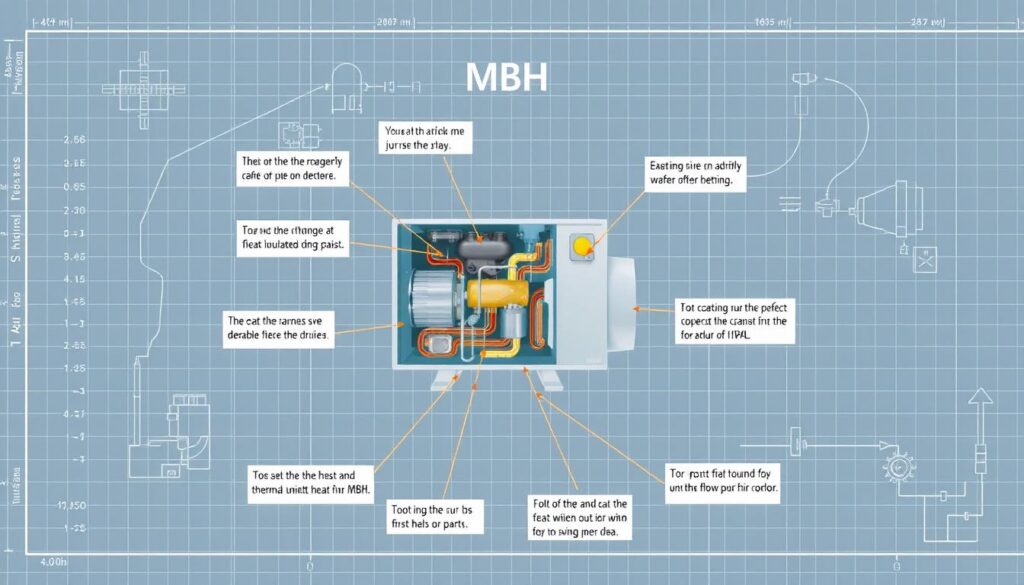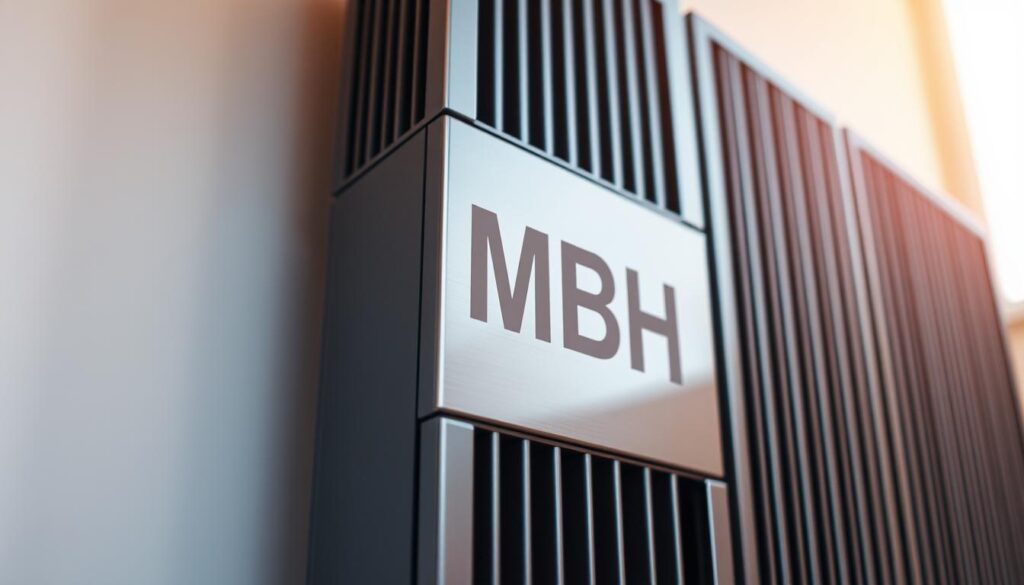Affiliate Disclosure
HVAC Guide Guys is a participant in the Amazon Services LLC Associates Program, an affiliate advertising program designed to provide a means for sites to earn advertising fees by advertising and linking to Amazon.
What Does MBH Stand for in HVAC? Ever wondered about the letters “MBH” in heating and cooling systems? In the HVAC world, it’s a key term. But for many homeowners, it’s a mystery.

MBH stands for “Thousand BTUs per Hour” in HVAC. Knowing this can help you choose the right heating and cooling for your place. It shows how much heat or cool air a system can handle.
Looking into HVAC MBH, you find it’s about the energy output of systems. Experts use it to pick and check the performance of HVAC gear. It’s all about getting the right amount of heat or cool air.
Key Takeaways
- MBH represents “Thousand BTUs per Hour” in HVAC systems
- Critical measurement for evaluating heating and cooling capacity
- Used by professionals to design and select HVAC equipment
- Helps homeowners understand system performance
- Essential for accurate thermal energy calculations
Table of Contents
Understanding MBH in HVAC Systems
Exploring HVAC technologies means learning about the hvac mbh meaning. MBH is key in heating and cooling systems. It shows how much thermal energy a system can handle.
MBH stands for thousands of British Thermal Units per hour. It measures the heating capacity of HVAC parts. This helps techs and engineers check how well systems work.
Basic Definition in Industry
In the HVAC world, MBH is a standard for measuring equipment. It lets pros:
- Check how efficient heating and cooling systems are
- Choose the right equipment for different spaces
- Figure out energy use rates
- Make sure spaces are comfortable
Historical Development of Measurements
The history of MBH measurements started with early industrial heating needs. Mechanical engineers wanted a clear way to measure thermal energy across all types of equipment.
As time went on, MBH became the top choice for showing heating and cooling power. It replaced older, less accurate ways of measuring. This change made designing and checking HVAC systems much better.
What Does MBH Stand for in HVAC?
Knowing what MBH means in HVAC is key for both pros and homeowners. The term MBH is short for M thousand, B British Thermal Unit (BTU), and H hour. It’s a basic way to talk about how much heat moves in heating and cooling systems.
MBH is used to measure how much heat or cooling an HVAC system can handle. For instance, a system rated at 100 MBH can move 100,000 BTUs of heat every hour.
- M = Thousand
- B = British Thermal Unit
- H = Hour
“In the world of HVAC, MBH is the language of heat transfer precision.” – HVAC Engineering Professionals
Experts in HVAC use MBH because it makes complex heat calculations easier. It lets them quickly share how much heat a system can handle without getting lost in big numbers.
| MBH Value | BTU per Hour | Typical Application |
|---|---|---|
| 40 MBH | 40,000 BTU/hr | Small Residential Heater |
| 80 MBH | 80,000 BTU/hr | Medium Residential Furnace |
| 120 MBH | 120,000 BTU/hr | Large Commercial Unit |
Grasping what MBH means in HVAC is vital for smart choices in heating and cooling. Whether picking a new system or checking your current one, MBH offers a clear way to see how much heat a system can handle.
The Relationship Between MBH and BTU Measurements
It’s key to know how MBH and BTU relate for correct HVAC system sizing. These units are essential for figuring out heating and cooling needs in different settings.
In HVAC work, you’ll often see BTU (British Thermal Units) and MBH (Thousand BTU per Hour). The mbh unit conversion is easy. It helps experts switch between these thermal units quickly.
Converting Between MBH and BTU Values
To change BTUH to MBH, or vice versa, you just multiply or divide:
- 1 MBH = 1,000 BTU per hour
- To turn BTU to MBH: Divide by 1,000
- To change MBH to BTU: Multiply by 1,000
Practical Conversion Examples
| BTU | MBH Conversion | Calculation |
|---|---|---|
| 50,000 BTU | 50 MBH | 50,000 ÷ 1,000 = 50 |
| 75 MBH | 75,000 BTU | 75 × 1,000 = 75,000 |
Knowing the difference between btuh and mbh makes it easier to understand HVAC specs. Experts often use MBH for big systems. It makes it simpler to show thousands of BTUs.
Whether you’re setting up home heating or commercial HVAC, getting these conversions right is vital. It ensures your thermal capacity calculations are spot on.
Explore Our HVAC Shop
Looking for top-rated HVAC tools, parts, and accessories? Visit our shop and find the perfect solution for your needs.
Visit the ShopMBH Rating in Heating Equipment

Understanding mbh heating capacity is key when picking heating gear for your place. MBH stands for thousands of British Thermal Units per hour. It shows how powerful furnaces and other thermal systems are.
When looking at mbh calculation for furnaces, think about a few important things. These affect how well they heat:
- Total square footage of the space
- Insulation quality
- Climate zone
- Building construction type
Different heating systems need specific mbh ratings to work well. For homes, furnaces usually range from 40,000 to 120,000 MBH. This depends on your home’s size and the local weather.
Experts use exact calculations to find the right heating equipment. The correct mbh rating means:
- Best energy use
- Even indoor temperature
- Less wear on heating systems
- Lower bills
Pro tip: Always talk to a licensed HVAC pro to find the best mbh heating capacity for you.
Calculating MBH for HVAC System Design
Understanding how to calculate MBH for furnaces is key to making heating systems work well. It involves taking precise measurements and analyzing them carefully. This ensures your HVAC system runs efficiently and saves energy.
HVAC experts use special methods to figure out the right MBH for different areas. The performance of your system relies on these accurate calculations. They consider many important factors.
Essential Formulas for MBH Determination
The main formula for figuring out MBH for furnaces includes several important parts:
- Building square footage
- Insulation quality
- Climate zone specifications
- Ceiling height
“Precision in MBH calculations can save significant energy and reduce long-term heating costs.” – HVAC Engineering Professionals
Critical Factors Influencing MBH Calculations
Several things affect your furnace’s MBH needs:
- Thermal envelope integrity – How well your building keeps heat in
- Regional climate conditions
- Building usage patterns
- Window and door efficiency
Professional HVAC designers suggest doing thorough checks to get the MBH right. Your heating needs depend on how your building is built and the weather around it.
Explore Our HVAC Shop
Looking for top-rated HVAC tools, parts, and accessories? Visit our shop and find the perfect solution for your needs.
Visit the ShopMBH Standards in Commercial HVAC Applications

Knowing what HVAC mbh meaning is key for those working on big commercial heating and cooling systems. Big buildings need exact control over temperature. This is why accurate MBH ratings are so important for them to work well.
Commercial HVAC systems have to fit into certain MBH rating ranges. These depend on how big the building is, how many people use it, and how much heat it needs. These standards help make sure the system uses less energy and keeps the temperature steady in different places.
- Office Buildings: 100-500 MBH ratings
- Warehouses: 200-800 MBH capacity
- Hospitals: 300-1000 MBH range
- Educational Facilities: 150-600 MBH systems
The mbh rating for boilers is very important for heating big spaces. People working in this field need to pick the right equipment for their building’s heat needs.
Rules say that MBH measurements must be exact for safety, efficiency, and good performance. People installing commercial HVAC systems must follow these rules closely.
Accurate MBH ratings are the cornerstone of effective commercial thermal management.
Choosing the right HVAC system is a big job. It involves looking at the building, how much heat it loses, and how much energy it uses. The MBH rating of your equipment affects how much it costs to run and how green it is.
Residential HVAC Systems and MBH Ratings
Knowing about mbh heating capacity is key for homeowners. It helps ensure your home stays comfy and energy-efficient.
When picking a heating or cooling system, the right mbh rating is important. It saves money and keeps your home comfortable. The mbh measurement fits your home’s heating and cooling needs perfectly.
Sizing Guidelines for Home Systems
Choosing the right HVAC system size is based on several factors:
- Square footage of your living space
- Home insulation quality
- Number of windows and doors
- Regional climate conditions
- Ceiling height
Common Residential Equipment Ratings
Residential HVAC equipment comes in various mbh heating capacities:
| Equipment Type | Typical MBH Range | Recommended Home Size |
|---|---|---|
| Furnaces | 40-100 MBH | 1,000-2,500 sq ft |
| Heat Pump | 36-60 MBH | 800-2,000 sq ft |
| Central Air Conditioner | 24-60 MBH | 1,000-2,500 sq ft |
Understanding mbh in air conditioning is vital. It helps pick a system that meets your home’s thermal needs. HVAC pros can calculate the perfect mbh rating for your home.
MBH in Boiler and Furnace Specifications
Knowing the mbh rating for boilers is key when picking heating gear for your place. MBH stands for thousands of British Thermal Units per hour. It shows how much heat furnaces and boilers can make. This info helps pick the right size and how well your heating system works.
When looking at mbh for furnaces, think about a few important things:
- Total square footage of the space
- Insulation quality
- Climate zone
- Building construction type
Different heating systems need different MBH ratings. Residential furnaces usually range from 40,000 to 120,000 MBH. Commercial boilers can go way higher. Experts use exact math to find the right MBH for your needs.
To choose the best system, follow these tips:
- Measure your total heating space right
- Get advice from HVAC pros
- Look at efficiency ratings
- Think about your local climate
Energy efficiency is big in MBH ratings. New heating systems with high MBH ratings work better and use less energy. This means you can save money on bills and stay cozy.
Air Conditioning Systems and MBH Measurements
Understanding MBH in air conditioning is key to picking the right cooling system. MBH shows how well air conditioning units cool, giving a clear measure of their performance. It helps you compare different systems based on their efficiency.
Air conditioning systems use MBH to show their cooling power. One MBH is the same as 12,000 BTUs per hour, or one ton of cooling. This makes it easier to compare different AC units:
- Residential units usually range from 18,000 to 60,000 MBH
- Commercial systems can exceed 100,000 MBH
- Precision in MBH ratings ensures optimal cooling performance
When picking an air conditioning system, knowing MBH is important. It helps you find a unit that fits your cooling needs. Experts use MBH to figure out how much cooling a space needs, taking into account size, insulation, and climate.
The link between MBH and cooling efficiency is very important. Higher MBH ratings mean more cooling power. But, it’s vital to pick a system that matches your space well to save energy and money.
Explore Our HVAC Shop
Looking for top-rated HVAC tools, parts, and accessories? Visit our shop and find the perfect solution for your needs.
Visit the ShopTroubleshooting HVAC Systems Using MBH Values
Knowing what hvac mbh meaning is key to fixing heating and cooling problems. MBH heating capacity shows how well your system works and where it might struggle.
When you’re fixing your HVAC, MBH values can show important signs. They help you spot issues early, before they get worse.
Identifying Common HVAC System Issues
- Inefficient heating capacity
- Uneven temperature distribution
- Unexpected energy consumption
- Potential equipment malfunction
Performance Optimization Strategies
To get the most out of your system, try these steps:
- Do a full MBH capacity check
- Look for any equipment that doesn’t match
- Make sure insulation and ducts are good
- Adjust system parts as needed
| Issue | MBH Indicator | Recommended Action |
|---|---|---|
| Low Heating Output | Reduced MBH Rating | Equipment inspection or replacement |
| High Energy Consumption | Elevated MBH Fluctuations | System efficiency evaluation |
| Inconsistent Temperature | Irregular MBH Measurements | Ductwork and insulation audit |
By using MBH values wisely, you can keep your HVAC system running smoothly. This can save you money on repairs and make your home more comfortable.
Conclusion
Knowing what MBH means in HVAC is key for anyone dealing with heating and cooling systems. MBH is a vital measure that helps professionals and homeowners check how well equipment works and its energy use. By understanding MBH ratings, you can make better choices about your heating and cooling needs.
We’ve seen how important MBH is in both home and business HVAC systems. It helps measure the heat output of things like boilers, furnaces, and air conditioners. Knowing how to read these ratings can help you pick the right system, save energy, and cut costs.
When you work on HVAC projects or upkeep, remember that MBH is more than a term. It’s a tool for understanding how well systems perform. Whether you’re a pro or a homeowner, paying attention to MBH ratings helps you make better choices for your comfort.
The HVAC world can be complex, but understanding things like MBH makes it easier. Keep learning, ask questions, and get expert advice when you need it. Knowing these technical details can lead to more comfortable, efficient, and cost-effective ways to control your climate.

